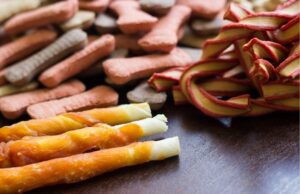If you’ve ever thought about turning your love for dogs and baking into a business, you might wonder, “Can I make and sell my own dog treats?” The short answer is yes, you can. However, there’s much more to consider before launching your dog treat business. This blog will guide you through the essential steps, from recipe development to legal requirements, packaging, and marketing.
1. Understanding the Market for Dog Treats
The pet industry is booming, with dog owners increasingly seeking high-quality, nutritious, and unique treats for their pets. The growing demand for natural and organic products extends to pet treats, making this a potentially lucrative market. However, it’s essential to understand your target audience and what sets your treats apart from the competition. Are your treats organic, grain-free, or tailored for specific dietary needs? Knowing your niche will help you craft a product that stands out.

2. Recipe Development: Creating Treats Dogs Will Love
Your dog treats need to be both safe and delicious. Start by researching ingredients that are safe for dogs and avoid common allergens like chocolate, onions, and certain nuts. Opt for wholesome ingredients such as sweet potatoes, oats, peanut butter (without xylitol), and lean meats.
Experiment with different recipes, keeping in mind the texture, taste, and nutritional value. Remember that dog treats can come in various forms—biscuits, chews, or soft treats—so choose a type that aligns with your brand and customer preferences.
Once you’ve developed a recipe, test it on a small group of dogs. Gather feedback from their owners about how much their dogs enjoyed the treats and any observations about digestion or health. This feedback will be invaluable as you refine your recipe.

3. Meeting Regulatory Requirements
Selling dog treats is not just about making something tasty—it’s about ensuring your products are safe and legal. The regulations for making and selling dog treats can vary significantly by location, so it’s crucial to research the requirements in your area.
In the United States, for example, the Food and Drug Administration (FDA) oversees pet food, including treats. You may need to adhere to specific labeling guidelines, manufacturing practices, and ingredient standards. State laws might also require you to obtain a business license, register your product, or have your kitchen inspected. Familiarize yourself with these regulations to avoid legal issues down the line.

4. Setting Up Your Kitchen: Home-Based or Commercial?
Depending on where you live, you might be able to produce dog treats in your home kitchen. However, some states and countries require commercial kitchens to ensure a controlled environment that meets health and safety standards.
If you opt for a home-based business, make sure your kitchen is clean and organized, with separate storage for ingredients and finished products to prevent contamination. Keep thorough records of your ingredients, recipes, and processes in case of an inspection.

For those needing a commercial kitchen, renting space in a shared kitchen facility could be a cost-effective option. These facilities often come equipped with industrial-grade appliances and storage, making it easier to produce larger batches.
5. Packaging and Labeling: Making a Good First Impression
Your packaging is the first thing customers see, so it’s crucial to make a good impression. Packaging should be not only attractive but also functional, keeping your treats fresh and safe during transport and storage.
In addition to aesthetics, your packaging must comply with labeling regulations. This typically includes listing all ingredients, nutritional information, net weight, and your company’s contact details. If your treats are organic or meet other specific standards, be sure to include those claims on the label, but only if you can substantiate them.

Consider eco-friendly packaging options to appeal to environmentally conscious consumers. Recyclable or biodegradable materials can set your brand apart in a crowded market.
6. Pricing Your Dog Treats: Finding the Sweet Spot
Pricing your dog treats can be challenging. You need to cover your costs—ingredients, packaging, labor, marketing—while also making a profit. At the same time, your price point should be competitive with other treats on the market.
Start by calculating the cost per unit, including all expenses involved in producing and packaging the treats. Then, decide on a markup that reflects the value of your product while remaining attractive to customers. Researching the prices of similar products will help you set a competitive price.
Keep in mind that as your business grows, your costs may decrease due to bulk purchasing and improved efficiency. Regularly review your pricing strategy to ensure it remains profitable and competitive.

7. Marketing and Selling Your Dog Treats
With your product ready, it’s time to get it in front of customers. There are multiple avenues for selling dog treats, both online and offline:
- Local Markets: Farmers’ markets, craft fairs, and pet expos are excellent places to start selling your dog treats. These venues allow you to interact directly with customers, receive feedback, and build a loyal following.
- Pet Stores: Approach local pet stores about carrying your treats. Offer free samples or promotional discounts to encourage them to give your product a try.
- Online Sales: Create an e-commerce website or sell through online marketplaces like Etsy, Amazon, or dedicated pet platforms. Use social media to showcase your products, engage with potential customers, and drive traffic to your site.
- Wholesale: Consider selling your treats in bulk to retailers or as private-label products. This option can significantly increase your sales volume but may require a different pricing strategy.
8. Building a Brand: More Than Just Treats
Successful dog treat businesses are built on strong brands that resonate with customers. Your brand is more than just your logo or product—it’s the story behind your business, the values you stand for, and the connection you make with your customers.
Develop a brand identity that reflects your unique selling proposition (USP). Are your treats all-natural? Do you donate a portion of your profits to animal shelters? Whatever sets you apart should be central to your branding and marketing efforts.

Consider creating a website, blog, or social media presence that reflects your brand’s personality. Share behind-the-scenes looks at your production process, post photos of happy dogs enjoying your treats, and engage with your audience through stories and content that resonate with them.
9. Scaling Your Business: When to Take the Next Step
As demand for your dog treats grows, you may find yourself considering ways to scale your business. Scaling can mean increasing production, expanding your product line, or entering new markets.
Before scaling, ensure that you have a solid foundation—a reliable production process, consistent quality, and a loyal customer base. Consider outsourcing certain tasks, such as packaging or shipping, to free up your time for product development and marketing.
Scaling can also involve moving from a home-based kitchen to a commercial facility, hiring staff, or investing in automation. While these steps require upfront investment, they can ultimately lead to greater efficiency and profitability.

10. Conclusion: From Passion to Profit
Making and selling your own dog treats can be a rewarding way to turn your passion for pets into a business. While there are many steps involved—from recipe development to meeting regulations and marketing—each one is an opportunity to refine your product and build a brand that resonates with dog owners.
With careful planning and a commitment to quality, you can create a successful dog treat business that not only provides a healthy and delicious option for pets but also brings joy to their owners. Whether you start small at local markets or aim for a broader audience online, the key is to stay true to your vision and continuously adapt to meet the needs of your customers and their furry friends.












